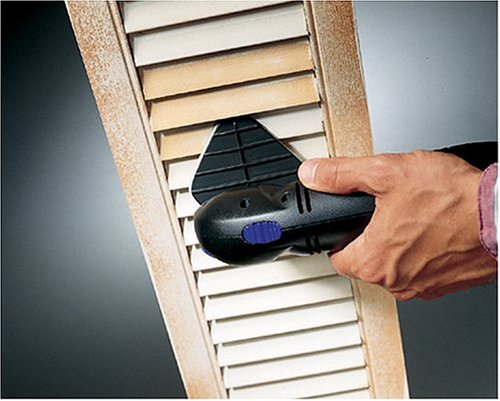|

The Dremel brand is so cool.
Why? Well, first you can buy 100s of different bits for the basic rotary Dremel. It polishes, grinds, sands, cuts, routers, engraves, and more. And now they’ve started branching out into specialty tools like the stylus and the contour sander.
But I’m getting ahead of myself, let’s first talk about sanding with the Dremel’s basic rotary tool.
Rotary Dremel (~$50-$100)
The variable speed rotary tool offers the best performance. For sanding purposes, they are compact, versatile, and offer great control.
The variable speed tool has a range of 5,000-35,000 rpm. Sanding drums work best at the lower end of this range.
There are a number of sanding attachments for the rotary Dremel device. Here are the ones I know of (and the line between sanding and grinding or polishing can be a thin one):
 Sanding bands (also called drums) and disks. These are the most common, and are used to sand just about anything.
Sanding bands (also called drums) and disks. These are the most common, and are used to sand just about anything. Flapwheels. As the flapwheel wears down, new abrasive is continuously exposed, preventing clogging and providing uniform finishing throughout the life of the flapwheel.
Flapwheels. As the flapwheel wears down, new abrasive is continuously exposed, preventing clogging and providing uniform finishing throughout the life of the flapwheel. Abrasive buffs are good for cleaning grills, removing paint and tarnish, and restoring hardware.
Abrasive buffs are good for cleaning grills, removing paint and tarnish, and restoring hardware. The abrasive brush can remove the surface layer (paint) without damaging the wood below. Good for contours and details.
The abrasive brush can remove the surface layer (paint) without damaging the wood below. Good for contours and details.  Wavy-edge sanding disks (not sold by Dremel) can do a better job of protecting your surfaces when sanding.
Wavy-edge sanding disks (not sold by Dremel) can do a better job of protecting your surfaces when sanding. Best used for:
- shaping rubber, fiberglass, and wood (woodcarving)
- removing rust from small surfaces or objects
- inside surfaces (otherwise hard to reach)
- Acrylic (I used my Dremel to sand an acrylic windshield and window for my toddler’s bed)
Care should be taken because…
- sanding drum wears out quickly (total area is pretty small), but are easy to replace.
- can leave scorch marks if used at too high a speed or if drum not replaced when grit has worn down
- will buck if placed against surface at too high a speed
Oscillating Dremel (Multi-Max) for Sanding  (~$100)
(~$100)
I’ve heard that the grip on this tool is a bit small for my guy friends… I guess that makes it even easier for us gals to use – whoohoo!
This tool is getting great reviews and costs a lot less than the Fein Multimaster. Among favored aspects are its compact design and ergonomic grip, speed variability (10,000-21,000 oscillations per minute), and the Quick Fit mechanism for switching between accessories quickly.
It is not good for sanding a large area, but provides a lot of control and precision for corners and details that would be trouble with an orbital sander.
Best used for:
This tool is getting great reviews and costs a lot less than the Fein Multimaster. Among favored aspects are its compact design and ergonomic grip, speed variability (10,000-21,000 oscillations per minute), and the Quick Fit mechanism for switching between accessories quickly.
It is not good for sanding a large area, but provides a lot of control and precision for corners and details that would be trouble with an orbital sander.
Best used for:
- paint, wood, metal, stone, cement, masonry
- rough to finish sanding
- sanding in tight spots
- preparing surface for tile replacement
Negatives:
- sandpaper sold in variety packs
- pad edges wear out a little bit prematurely
- heats up (probably because guys with big hands are covering a vent hole)
- Not for large surfaces
This review only covers Dremel, but here are similar tools:
Bosch 1294VSK Sander
Fein Multimaster
Dremel Contour Sander  (~$50)
(~$50)
The newest thing to hit sanding, the Dremel Contour Sander is what you want for Christmas.
The site says it “eliminates hand sanding”. Could this be true?? Well, it is variable speed (4,000 to 10,000 strokes per minute) so the control is very good. It’s slower than the Multi-Max, so it is a nice compliment for those more sensitive sanding jobs.
It also comes with a variety of attachments for different surfaces. The sanding tubes or profiles are for detail sanding of the nooks, deep grooves, intricate carvings, spindles and other irregular shapes. The detail pads are for the crannies, curved moldings, trim and other tight corners and spaces. Finally, the extension detail pad sticks out for tight spaces like shutters.
I love this picture of a shutter being sanded with the Dremel Contour Sander… Be still my heart!
I love this picture of a shutter being sanded with the Dremel Contour Sander… Be still my heart!

Best used for:
- jobs normally left to hand sanding
- very light finish sanding
- sanding after using wood fillers
- shutters, grooves, moldings, carvings, thin slats, spindles, and
- trim! (a mouse sander or the Multi-Max is faster and more powerful, but will scuff the wall)
Negatives:
- Too slow for “regular” jobs
- Sanding tubes can be cut to size, but won’t fit if cut too small
- not random-orbital, so attend to the direction of the grain of wood when sanding
- expensive sanding tubes
Finally, it takes practice to handle the profiles while sanding. This is true of all profile sanders.
Just like the previous review of power sanders, each is suited to its own range of tasks.
Like any tool, these take practice to become proficient with.
Tips for using:
- All sanders should be kept moving to avoid damaging your surface.
- As a general rule, smaller accessories and mandrels can be used at higher speeds than larger accessories and mandrels.
Again, sandpaper and sanding pads come in a variety of grits, and for these tools they are usually just called fine (240), medium (120), and coarse (60). Coarse grits are good for removal of stock (removing wood by sanding). Finer grits are ideal for finish sanding prior to the application of paint or varnish.
In the end I feel like I could still write a few more pages about these tools. Do you use one? Like it? What projects have you done?
(BTW, I have no connection to nor was I paid by Dremel for this content.)

New to Pregnant with power tools? Don't miss a post and subscribe here...
 Email Updates
Email Updates








Thanks for sharing this Post, Keep Updating such topics.
How to Carve Wood with a Dremel Tool?
Dremel Tools was established in 1932, first producing the handheld, high-speed rotary tool named the Moto-Tool. The versatility and high performance of the first few products attracted DIY-ers and tradesmen alike. Because Dremel strives to empower users, the brand expanded beyond rotary tools, offering a full line of versatile tools. To further support users, the corded and cordless lineup includes oscillating tools, screwdrivers, grinding stones, compact saws, drill bits, specialty sandpaper products, more than 150 accessories, and multiple attachments. With over 85 years of experience, Dremel has become a brand that users know and trust.
The information in this article is satisfied me.It is really helpful. Thanks for this kind of article. And the information it is very interesting. the fish finders fisher manfamily camping"
Thank you so much for such an informative piece of information :)
If anyone interested similar one's have a look here
diysbest
Thanks
you need to have time to take care of the kids active.play exciting flash games. you want to relax after a stressful working hours, When you're tired, Thanks you for sharing! oscillating tool tips Projects with Oscillating Tool Oscillating Tool Tips Remove Grout with Oscillating Tool